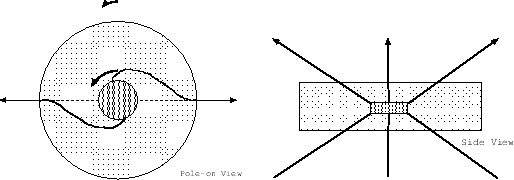Next: Centrifugal Radius Up: Magneto-driven Model Previous: Problem Contents
In the axisymmetric case, the poloidal ![]() and toroidal
and toroidal ![]() components of the magnetic field
components of the magnetic field
![]() and current
and current
![]() are decoupled with each other.
That is, the poloidal (
are decoupled with each other.
That is, the poloidal (![]() ) and toroidal (
) and toroidal (![]() ) magnetic fields are made
by the toroidal (
) magnetic fields are made
by the toroidal (![]() ) and poloidal (
) and poloidal (![]() ) electric currents, respectively.
As for the Lorentz force
) electric currents, respectively.
As for the Lorentz force
![]() , the poloidal component comes from
, the poloidal component comes from ![]() or
or
![]() , while the toroidal component does from
, while the toroidal component does from
![]() .
Even if there is no toroidal magnetic field (thus no poloidal electric current),
there exists the poloidal component of the Lorentz force, which acts as a pressure to counter-balance
the self-gravity (
.
Even if there is no toroidal magnetic field (thus no poloidal electric current),
there exists the poloidal component of the Lorentz force, which acts as a pressure to counter-balance
the self-gravity (![]() 4.2).
On the other hand, the toroidal component of the Lorentz force appears only the case with
the poloidal electric current and thus toroidal component of magnetic field
4.2).
On the other hand, the toroidal component of the Lorentz force appears only the case with
the poloidal electric current and thus toroidal component of magnetic field ![]() .
This means that the angular momentum is transferred by the magnetic field only when
.
This means that the angular momentum is transferred by the magnetic field only when ![]() exists.
Equation (B.14) explains how the angular momentum density
exists.
Equation (B.14) explains how the angular momentum density ![]() is transferred.
The left-hand side of equation (B.14) represents
the advection of the angular momentum density, while the right-hand side
is transferred.
The left-hand side of equation (B.14) represents
the advection of the angular momentum density, while the right-hand side
 |
The induction equation of the magnetic field [eq.(B.17)]
shows that ![]() is generated from poloidal magnetic field
by the effect of rotational motion
is generated from poloidal magnetic field
by the effect of rotational motion ![]() .
This indicates that the angular momentum is transferred as follows:
.
This indicates that the angular momentum is transferred as follows:
Kohji Tomisaka 2012-10-03